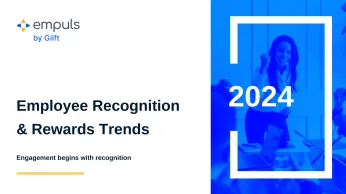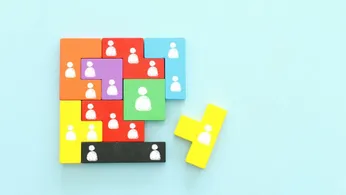Di halaman ini
Forget everything you thought you knew about the 9-to-5. Cubicles? Optional. Job titles? Fluid. AI? Not just a buzzword anymore—it’s your new colleague. The future of work isn’t coming. It’s already here, and it’s rewriting the rules in real time.
From workplace trends like hyper-personalized employee experiences to workforce trends such as skills-first hiring and boundaryless career paths, 2025 is shaping up to be the year companies either adapt—or fall behind. Gartner calls out a shift toward trust-based leadership and “quiet hiring” to fill evolving skill gaps.
Forbes predicts hybrid work will become the default, with well-being moving from a perk to a business imperative. Deloitte emphasizes tech-human convergence, where AI and automation empower—not replace—talent.
These aren’t just fleeting predictions. They’re the playbook for organizations that want to build cultures where people and performance thrive together. In this article, we’ll break down the most impactful workforce and workplace trends that are transforming everything from recruiting to retention, employee engagement to leadership strategy. Buckle up—this is the work revolution.
Statistic significance that showcases the future of work in 2025 and beyond
The International Monetary Fund recently forecasted that the fear of widespread recession in the world economy is fading amid the widening global divergence. Moreover, the IMF has also shared in the same report that the global headline inflation is expected to decline to 4.2% in 2025.
Moreover, in the U.S., the labour market is going strong as ever. In March 2025, total nonfarm payroll employment rose by 228,000, surpassing the average monthly gain of 158,000 over the prior 12 months.
Dengan prospek ekonomi yang sedikit membaik menjadi lebih baik, ini adalah saat di mana antisipasi terhadap apa yang akan terjadi selanjutnya banyak dipuji dalam bentuk 'Tren Tenaga Kerja'. Dekade terakhir membawa perubahan revolusioner di dunia korporat, dan bukan hanya eksodus budaya setelan jas dan dasi yang terlihat.
The statistics are yet to come out with an embossed sigil, but the unemployment rate in the US of A has de-escalated in comparison to last year, according to the Bureau of Labour Statistics.
The statistics are yet to come out with an embossed sigil, but the unemployment rate in the US of A has de-escalated in comparison to last year, according to the Bureau of Labour Statistics. As of March 2025, the unemployment rate stood at 4.2%, remaining within a narrow range since May 2024.
Not only does this exemplify that it will get better next year, but it also explains that the automation and arrival of Artificial Intelligence and Machine Learning, something that the workforce considers to be its arch-nemesis, doesn’t gulp their jobs.
Workforce trend predictions for 2025
Mari kita lihat 8 prediksi paling masuk akal dalam tren tenaga kerja yang berpeluang besar masuk ke kantor-kantor di sekitar Anda. Setiap kali tahun baru tiba, para karyawan menyambutnya dengan semangat yang tinggi, resolusi baru, dan, dalam beberapa kasus, pekerjaan baru, dan tentu saja, tren baru di tempat kerja.
1. Integration of AI in HR processes
Artificial Intelligence is revolutionizing HR by streamlining processes and enhancing decision-making. Gartner highlights that AI's implementation within HR will lead to the shifting of roles over time, necessitating fewer people to complete the same amount of work.
SAP's SuccessFactors suite exemplifies this transformation. The integration of AI capabilities, such as the AI assistant Joule, assists in tasks ranging from generating job descriptions to analyzing employee performance data.
Furthermore, AI-driven analytics are providing deeper insights into employee engagement and retention patterns. By leveraging these insights, HR departments can proactively address potential issues, tailor development programs, and enhance overall employee satisfaction.
As AI continues to evolve, its role in HR will expand, offering more sophisticated tools for talent acquisition, performance management, and employee development. Embracing these technologies will be crucial for organizations aiming to stay competitive in the modern workforce landscape.
2. Pekerjaan jarak jauh akan menang
Remote work is very much in contention to be the buzzword of 2025 as it is something that the workforce is very much looking forward to teaching in their daily lifestyle.
Now that flexible work hours are the corporate equivalent of the new world order, this calls for a more dedicated workforce that can function round the clock if needed (Author’s Note: I’m writing this bit while watching Manchester United play at home).
Lewatlah sudah hari-hari ketika pekerjaan dilakukan dari jam sembilan sampai jam lima, dan telah berevolusi menjadi menyelesaikan sesuatu lebih dari apa pun.
In a survey conducted by Buffer in collaboration with various bigwigs, it was found that 90% of workers who have worked remotely before, wish to do the same for the rest of their lives.
Studi budaya perusahaan oleh Kronos menunjukkan bahwa 71% pekerja percaya bahwa jam kerja yang kaku menghambat kehidupan pribadi mereka. Hal ini tidak hanya membuktikan pentingnya fleksibilitas, tetapi juga menunjukkan bahwa bukan hanya permainan menghangatkan bangku di meja kerja yang dapat menyelesaikan pekerjaan.
One study has shown that a whopping 80% of executives feel contrite about the return-to-office decisions, pushing continuation of the opportunity to increase remote and hybrid work-mode in action in 2025. Moreover, a study from Gallup has found that 8 out of 10 CHROs from the Fortune 500 have no plans to decrease work flexibility in the upcoming year.
3. Kesetaraan gender tidak lagi tentang menyeimbangkan timbangan
Jika dipikir-pikir, berkat semua upaya yang dilakukan, masalah kesetaraan gender bukanlah masalah yang mengkhawatirkan. Telah ditemukan bahwa keragaman gender memiliki dampak yang sangat besar terhadap profitabilitas (Ernst & Young).
Sebuah organisasi yang bergerak dari nol pemimpin wanita menjadi 30% pemimpin wanita menyaksikan peningkatan 15% dalam margin pendapatan bersih-sesuatu angka yang cukup kuat dalam hal jumlah yang meroket.
Namun, bukan hanya profitabilitas dan angka-angka yang mengakhiri perdebatan. Berbagai organisasi secara aktif mulai menghormati orientasi seksual individu di tempat kerja dengan mendukung kebijakan asuransi kesehatan dan asuransi jiwa bagi mitra dengan identitas LGBTQ+.
Ini adalah langkah penting untuk kemajuan kita sebagai masyarakat, dan karyawan merasa terhormat untuk bekerja dengan organisasi yang menghormati siapa mereka. Tahun baru akan menjadi saksi revolusi besar dalam menormalkan identitas dan orientasi gender. Sebaiknya semua orang beradaptasi dengan hal ini, baik pemberi kerja maupun karyawan.
4. Gaji & tunjangan harus tetap menjadi motivator utama
If someone’s wondering whether 2025 would be the year when employees would fall for the “don’t work for the money” speech, then let’s burst that bubble—salary and the benefits will stay on as critical motivators for a quintessential employee.
Namun, faktor-faktor ini bersaing ketat dengan keamanan kerja jangka panjang, kesempatan untuk meningkatkan jenjang karier, dan suasana kerja yang menyenangkan.
While an employer’s priority lies in hiring an employer that helps the organization become financially healthy, uses the latest technology, and carries a very good reputation, you can easily see the gap between employee-employer demands (Randstad).
This has to be curbed to build a healthy culture where employees are recognized for their work and engaged to the max.
5. Komunikasi formal akan menjadi lebih informal
Sekarang platform seperti Slack, Google Business Hangouts, Skype, dan ratusan platform lainnya secara dominan digunakan oleh organisasi untuk komunikasi intra-kantor, templat email buku teks akan segera berkembang.
The salutations and pleasantries will slowly be cut out as instant messaging (IM) platforms make verbal communication handier and more accessible.
Memang benar jika dikatakan bahwa saluran komunikasi formal yang megah seperti email tidak dapat digantikan. Namun, untuk komunikasi internal dan kolaborasi antar tim, obrolan grup akan lebih efektif daripada utas email yang berlangsung bermil-mil jauhnya.
6. Karyawan milenial tidak akan lagi menjadi pengembara pekerjaan
Generasi milenial sering dikenal dengan stereotip 'bolos kerja' karena sebagian besar dari mereka terus mencari peluang untuk meningkatkan jabatan dan gaji mereka.
Seiring berjalannya dekade terakhir, generasi milenial kini berkomitmen penuh untuk menetap daripada berganti pekerjaan. 90% dari generasi milenial akan bertahan di pekerjaan mereka saat ini selama lebih dari sepuluh tahun jika mereka ditawari dua hal:
- Kenaikan gaji tahunan
- Kenaikan di tangga perusahaan
This conclusion came from a CNBC-exclusive survey with Qualtrics, wherein many exciting findings were discovered. It was found that almost 40% of millennials would stay at their current job if they liked it, and only 36% of the total would leave it for a better opportunity.
Mengenai stereotip bahwa karyawan milenial memiliki satu kaki di luar pintu, hanya 3% milenial yang mengatakan bahwa mereka tidak suka menghabiskan seluruh waktu mereka untuk satu pekerjaan, yang membantah mitos tersebut.
Stereotip 'Job Nomad' belum hilang. Namun, stereotip ini akan berpindah dari satu generasi ke generasi lainnya. Tidak akan mengejutkan jika Gen-Z akan segera menyandang predikat tersebut.
7. Generasi baby boomer akan kembali bangkit
Kembali ke para pelaku awal dari piring lintas generasi ini, jumlah pekerja berusia 65 tahun atau lebih secara aneh telah meningkat.
Tetapi mengapa generasi baby boomer kembali bangkit? Hal ini terjadi bukan hanya karena pekerjaan yang ada tidak lagi 'menakutkan secara fisik' seperti sebelumnya, tetapi juga karena mereka membawa banyak pengetahuan. Banyak generasi baby boomer juga mencari pekerjaan karena mereka tidak dapat merencanakan 'rencana pensiun yang indah', sehingga memaksa mereka untuk kembali bekerja.
8. Otomatisasi akan membuat pekerjaan menjadi lebih mudah & tidak menelan mereka
Whenever there's talk of Artificial Intelligence (AI), machine learning, automation, or self-driving cars, the first thought that comes to the employees is," what about our jobs?"
Otomatisasi dan penggabungan upaya manusia dan teknologi benar-benar telah menghasilkan hal-hal yang menakjubkan di masa lalu, dan kolaborasi ini akan semakin meningkat seiring dengan perkembangan zaman.
This Oxford research on how susceptible our jobs are to automation highlighted back in 2013 how more than 40% of jobs were at risk thanks to the rise of automation.
Now that AI is coming in with the 5th Industrial Revolution, the job risk would surely be there, but jobs won't be lost to ones who update their knowledge base.
No, that doesn't mean that data-operators are supposed to learn machine learning, but at least they have to gear up with the change. AI and automation are just here for the betterment of consumers, ease for businesses, and make employees' jobs simpler. Learn how AI can help in recruitment.
The narrative surrounding automation often centers on job displacement. However, in 2025, the focus is shifting towards how automation can augment human roles rather than replace them. According to Gartner, by 2036, AI solutions introduced to augment or autonomously deliver tasks are expected to result in over half a billion net-new human jobs.
This evolution means that while certain repetitive tasks may be automated, new roles requiring advanced skills will emerge. For instance, SAP's AI-driven tools are enabling HR professionals to focus more on strategic initiatives by automating routine administrative tasks.
Moreover, organizations are investing in upskilling programs to prepare their workforce for this transition. Emphasizing continuous learning ensures that employees can adapt to new technologies and workflows, fostering a more resilient and versatile workforce.
9. Rise of internal talent marketplaces
Organizations are increasingly leveraging internal talent marketplaces to facilitate employee mobility and career growth. By utilizing AI-driven platforms, companies can match employees to internal opportunities, fostering retention and skill development.
10. Emphasis on holistic employee well-being
Employers are adopting a comprehensive approach to employee well-being, addressing mental, physical, and financial health. This includes offering personalized wellness programs, financial planning resources, and initiatives to promote work-life balance.
11. Gen-Z’s arrival with screens and memes
Transisi keragaman usia tidak dapat dihindari, dan saat kita menyambut tahun baru dengan penuh semangat, Gen-Z akan secara resmi menjadi pusat perhatian dari generasi baby boomer (setidaknya mereka akan mencoba untuk melakukannya; lebih lanjut mengenai hal ini nanti).
Generasi muda yang penuh semangat yang lahir antara akhir tahun 90-an hingga akhir tahun 2000-an ini memiliki cara pandang yang berbeda sama sekali-sesuatu yang dapat dimanfaatkan oleh manajemen.
Sure, the fact that they are #AlwaysActive on social media and use up to 5 screens at once does put them in a bad light, but in reality, this is what makes Gen-Zers an invaluable asset.
More than a third of Gen-Zers in the workforce believe that engagement is the key to retention and better performance. That same proportion hankers for feedback from their superior/boss to become a better version of themselves.
Not only does this make it crystal clear that an organization has to tweak its engagement and recognition strategies accordingly, but it also offers its workforce more ownership than what they were doing already. This high-flying generation doesn’t simply get the job done, but it takes ownership of it as well.
Now that 2025 rolls on, we can surely expect more youngies in casuals loitering around with smart wearables on their clothes, headphones in their ears, and smartphones in their hands.
Workplace trends in 2025
Dengan perusahaan-perusahaan yang menyaksikan pergeseran signifikan dalam perekrutan generasi, dan kebangkitan generasi milenial, hanya adopsi tren terkini berdasarkan kebutuhan tenaga kerja yang beragam yang dapat membuat tempat kerja menjadi bahagia.
PwC’s Global Workforce Hopes and Fears Survey 2023 quoted, “You have to reinvent your organization, but without the support and energy of all your people, these efforts will fail.” This forces the need to focus on implementing trendy aspects into the workplace for a better agreement with the workforce. So, let’s go through a few workplace trends.
1. Inclusion of diversity, equity, and inclusion (DE&I)
A strong focus must remain on fostering a diverse workforce rooted in inclusive practices. Talent acquisition strategies should prioritize equitable opportunities regardless of gender, ethnicity, or background.
Alongside recruitment, continuous training and development should promote fair access to growth and leadership. DE&I isn’t just a checkbox—it’s foundational to modern workplace trends, influencing innovation, culture, and retention.
2. Flexible work models becoming standard
Hybrid work models—combining in-office and remote flexibility—are becoming central to workplace trends across industries. According to Forbes, an estimated 32.6 million Americans will choose to work remotely by the end of 2025.
With remote work shown to improve productivity and employee satisfaction, companies must rethink office space, technology, and policies to support this evolving dynamic. Embracing flexible work arrangements is key to attracting and retaining top talent.
Hybrid and remote work arrangements are solidifying as standard practices. Organizations are investing in technology and infrastructure to support flexible work, ensuring productivity and collaboration across various work settings.
3. Shifting management focus to problem-solving
Today’s managers must move beyond task delegation and adopt a problem-solving mindset. Leaders should empower their teams to take responsibility, innovate, and lead projects independently.
Rather than focusing on micromanagement, managers should aim to streamline workflows and enhance efficiency. In HR, this means eliminating clerical roles and embracing strategic initiatives aligned with broader business goals—reflecting a major shift in workplace trends.
4. Enhanced office amenities to encourage on-site work
To entice employees back to physical offices, companies are upgrading workplace amenities. This includes offering wellness facilities, gourmet dining options, and recreational spaces to create a more appealing work environment.
How Empuls enables organizations to adapt to future of work trends
In the evolving narrative of the workplace, Empuls by Xoxoday stands out as a powerful enabler for organizations adapting to the future of work.

Empuls provides a unified platform for employee engagement, recognition, communication, surveys, and well-being initiatives, all of which align closely with the most pressing 2025 workforce trends. Here's how:
- Engaging Gen-Z and millennials: Empuls gamifies feedback and engagement, meeting younger employees where they are—digitally, socially, and interactively.
- Supporting remote and hybrid work: With social intranet-style features, real-time recognition, and virtual celebrations, Empuls keeps distributed teams connected and motivated.
- Driving inclusivity and recognition: Empuls helps institutionalize DE&I efforts by celebrating diverse identities and encouraging peer-to-peer appreciation.
- Boosting retention through benefits: With curated reward catalogs and performance-based incentives, Empuls directly influences retention, satisfaction, and productivity.
- Modernizing communication: Empuls seamlessly integrates with Slack, MS Teams, and more, bringing informal yet meaningful conversations into the workflow.
Whether you're embracing flexible work models, empowering intergenerational teams, or modernizing workplace culture, Empuls is built to help you lead the future of work. So, schedule a call now!
Kesimpulan
As we step into 2025, the workplace is evolving faster than ever before. The rise of Gen-Z, the dominance of remote work, the deepening of DE&I, and the impact of automation are just some of the many workforce trends shaping what lies ahead.
To remain relevant and resilient, organizations must understand and embrace these shifts—not just react to them. The future of work isn’t just a forecast; it’s an invitation to rethink how we work, why we work, and what makes work meaningful.
With the right strategies, tools like Empuls, and a people-first mindset, businesses can not only adapt to future of work trends—they can lead them.













